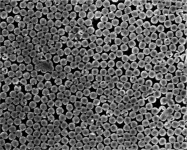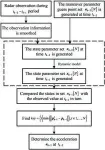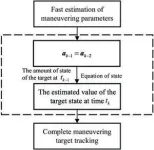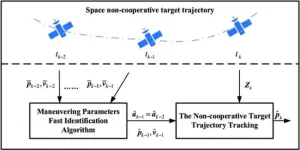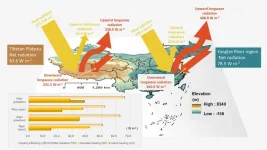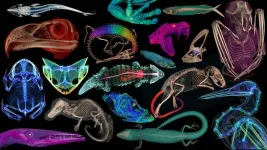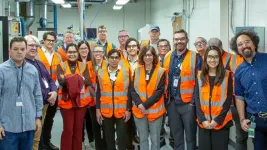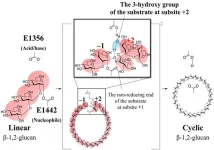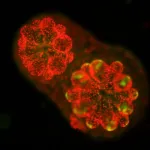(Press-News.org) Evaporation is a natural process so ubiquitous that most of us take it for granted. In fact, roughly half of the solar energy that reaches the earth drives evaporative processes. Since 2017, researchers have been working to harness the energy potential of evaporation via the hydrovoltaic (HV) effect, which allows electricity to be harvested when fluid is passed over the charged surface of a nanoscale device. Evaporation establishes a continuous flow within nanochannels inside these devices, which act as passive pumping mechanisms. This effect is also seen in the microcapillaries of plants, where water transport occurs thanks to a combination of capillary pressure and natural evaporation.
Although hydrovoltaic devices currently exist, there is very little functional understanding of the conditions and physical phenomena that govern HV energy production at the nanoscale. It’s an information gap that Giulia Tagliabue, head of the Laboratory of Nanoscience for Energy Technology (LNET) in the School of Engineering, and PhD student Tarique Anwar wanted to fill. They leveraged a combination of experiments and multiphysics modelling to characterize fluid flows, ion flows, and electrostatic effects due to solid-liquid interactions, with the goal of optimizing HV devices.
“Thanks to our novel, highly controlled platform, this is the first study that quantifies these hydrovoltaic phenomena by highlighting the significance of various interfacial interactions. But in the process, we also made a major finding: that hydrovoltaic devices can operate over a wide range of salinities, contradicting prior understanding that highly purified water was required for best performance,” says Tagliabue.
The LNET study has recently been published in the Cell Press journal Device.
A revealing multiphysics model
The researchers’ device represents the first hydrovoltaic application of a technique called nanosphere colloidal lithography, which allowed them to create a hexagonal network of precisely spaced silicon nanopillars. The spaces between the nanopillars created the perfect channels for evaporating fluid samples, and could be finely tuned to better understand the effects of fluid confinement and the solid/liquid contact area.
“In most fluidic systems containing saline solutions, you have an equal number of positive and negative ions. However, when you confine the liquid to a nanochannel, only ions with a polarity opposite to that of the surface charge will remain,” Anwar explains. “This means that if you allow liquid to flow through the nanochannel, you will generate current and voltages.”
“This goes back to our major finding that the chemical equilibrium for the surface charge of the nanodevice can be exploited to extend the operation of hydrovoltaic devices across the salinity scale,” adds Tagliabue. “Indeed, as the fluid ion concentration increases, so does the surface charge of the nanodevice. As a result, we can use larger fluid channels while working with higher-concentration fluids. This makes it easier to fabricate devices for use with tap or seawater, as opposed to only purified water.”
Water, water everywhere
Because evaporation can occur continuously over a wide range of temperatures and humidities – and even at night – there are many exciting potential applications for more efficient HV devices. The researchers hope to explore this potential with the support of a Swiss National Science Foundation Starting Grant, which aims to develop “a completely new paradigm for waste-heat recovery and renewable energy generation at large and small scales,” including a prototype module under real-world conditions on Lake Geneva.
And because HV devices could theoretically be operated anywhere there is liquid – or even moisture, like sweat – they could also be used to power sensors for connected devices, from smart TVs to health and fitness wearables. With the LNET’s expertise in light energy harvesting and storage systems, Tagliabue is also keen to see how light and photothermal effects could be used to control surface charges and evaporation rates in HV systems.
Finally, the researchers also see important synergies between HV systems and clean water generation.
“Natural evaporation is used to drive desalination processes, as fresh water can be harvested from saltwater by condensing the vapor produced by an evaporative surface. Now, you could imagine using an HV system both to produce clean water and harness electricity at the same time,” Anwar explains.
END
Nanodevices can produce energy from evaporating tap or seawater
EPFL researchers have discovered that nanoscale devices harnessing the hydroelectric effect can harvest electricity from the evaporation of fluids with higher ion concentrations than purified water, revealing a vast untapped energy potential.
2024-03-06
ELSE PRESS RELEASES FROM THIS DATE:
Scientist proposed a research on space noncooperative target trajectory tracking based on maneuvering parameter estimation
2024-03-06
Firstly, the authors briefly describe two models for tracking the maneuvering trajectories of non-cooperative space targets: the relative dynamics model and the indirect measurement model. In the relative dynamics model, tracking the maneuvering trajectory of the target is modeled as a problem of tracking the target's position over short discrete time intervals. On the other hand, the indirect measurement model transforms radar-derived values directly into measurements in the Local Vertical Local Horizontal (LVLH) coordinate system.
Next, the authors address the tracking problem of targets ...
Scientists uncover comparable net radiation between the high-elevation Tibetan Plateau and the low-elevation Yangtze River region
2024-03-06
Land–atmosphere interactions play a crucial role in shaping Earth’s climate system, profoundly influencing weather patterns, climate variables, and ecological processes. Despite being located at similar latitude, the Tibetan Plateau (TP) and Yangtze River region (YRR) represent two distinct climate zones, garnering significant attention in this field. The former, situated in western China at an altitude exceeding 4000 m, is characterized by an arid climate, whereas the latter, located in the eastern Chinese plain, experiences a humid climate. Although both the TP and YRR have ...
Why some RNA drugs work better than others
2024-03-06
Spinal muscular atrophy, or SMA, is the leading genetic cause of infant death. Less than a decade ago, Cold Spring Harbor Laboratory (CSHL) Professor Adrian Krainer showed this brutal disease can be treated by tweaking a process called RNA splicing. This breakthrough resulted in Spinraza, the first effective treatment for SMA. It also opened a new frontier in drug development. Now, CSHL research could push RNA-splicing drugs even further. CSHL Associate Professor Justin Kinney, Krainer, and postdoc Yuma Ishigami have ...
Scientists-CT scanned thousands of natural history specimens, which you can access for free
2024-03-06
Read the online version (Available 8:00 a.m. ET, March 6, 2024)
Watch the video (Embargoed. Do not distribute before 8:00 a.m. ET, March 6, 2024)
Natural history museums have entered a new stage of scientific discovery and accessibility with the completion of openVertebrate (oVert), a five-year collaborative project among 18 institutions to create 3D reconstructions of vertebrate specimens and make them freely available online.
Researchers published a summary of the project in the journal BioScience in which they review the specimens that have been scanned to date and offer a glimpse of how the data might be used to ask new questions ...
INFUSE workshop gives private and public fusion partners a chance to network and share experiences
2024-03-06
More than 120 people gathered for the 2024 Innovation Network for Fusion Energy (INFUSE) Workshop at the U.S. Department of Energy’s (DOE) Princeton Plasma Physics Laboratory (PPPL) from Feb. 27-28.
The event, which was sponsored by the DOE’s Office of Fusion Energy Sciences (FES), is a part of the INFUSE awards program that funds laboratories or universities so they can partner with private sector companies working on the science and technology ...
Uncovering the cyclization mechanism of cyclic β-1,2-glucan synthase
2024-03-06
The polysaccharide β-1,2-glucan consists of repeating units of glucose linked together by β-1,2-glycosidic bonds. Cyclic β-1,2-glucans (CβGs) occur in different bacterial species and have a role in bacterial infections and symbiotic relationships. CβG biosynthesis is catalyzed by cyclic β-1,2-glucan synthase (CGS), an enzyme that catalyzes the cyclization (closed ring formation) of linear β-1,2-glucan (LβG).
Since the method for large-scale enzymatic synthesis of linear β-1,2-glucan has already been established, combining it with this enzyme is technically feasible for efficient ...
Marine algae implants could boost crop yields
2024-03-06
Scientists have discovered the gene that enables marine algae to make a unique type of chlorophyll. They successfully implanted this gene in a land plant, paving the way for better crop yields on less land.
Finding the gene solves a long-standing mystery amongst scientists about the molecular pathways that allow the algae to manufacture this chlorophyll and survive.
“Marine algae produce half of all the oxygen we breathe, even more than plants on land. And they feed huge food webs, fish that get eaten by mammals and humans,” said UC Riverside ...
Model estimates who benefits most from frequent COVID-19 boosters
2024-03-06
Patients kept asking a question that Nathan Lo, MD, PhD, infectious disease specialist, had a hard time answering: How often should I get my booster shot for COVID-19?
“It’s a question that we have all asked. My patients have asked; friends and family members have asked,” Lo said. “We point to the national vaccine recommendations, although increasingly this question has become challenging to answer. I didn’t quite have the estimates on hand that I might hope to share with patients.”
To build that evidence, Lo and his team at Stanford ...
XPANCEO and Nobel laureate unveil the new properties discovery in graphene-like materials, transforming healthcare, AI and AR
2024-03-06
XPANCEO, a deep tech company developing the first smart contact lenses with XR vision, health monitoring, and content surfing features, in collaboration with the Nobel laureate Konstantin S. Novoselov (National University of Singapore, University of Manchester) and professor Luis Martin-Moreno (Instituto de Nanociencia y Materiales de Aragon), has announced in Nature Communications a groundbreaking discovery of new properties of rhenium diselenide and rhenium disulfide, enabling novel mode of light-matter interaction with huge potential for integrated photonics, healthcare, and AR. Rhenium disulfide ...
More than half of American Indian youth may have abnormal or high cholesterol
2024-03-06
More than 70% of American Indian young adults aged 20-39 and 50% of American Indian teens have cholesterol levels or elevated fat in the blood that put them at risk for cardiovascular disease, suggests a study supported by the National Institutes of Health. In some cases, these levels — specifically high low-density lipoprotein (LDL) cholesterol, often thought of as “bad cholesterol,” — were linked to plaque buildup and cardiovascular events, such as heart attack and stroke.
The findings, ...
LAST 30 PRESS RELEASES:
Bluey’s dad offered professorial chair in archaeology at Griffith University
Beyond small data limitations: Transfer learning-enabled framework for predicting mechanical properties of aluminum matrix composites
Unveiling non-thermal catalytic origin of direct current-promoted catalysis for energy-efficient transformation of greenhouse gases to valuable chemicals
Chronic breathlessness emerging as a hidden strain on hospitals
Paleontologists find first fossil bee nests made inside fossil bones
These fossils were the perfect home for ancient baby bees
Not everyone reads the room the same. A new study examines why.
New research identifies linked energy, immune and vascular changes in ME/CFS
Concurrent frailty + depression likely boost dementia risk in older people
Living in substandard housing linked to kids’ missed schooling and poor grades
Little awareness of medical + psychological complexities of steroid cream withdrawal
Eight in 10 trusts caring for emergency department patients in corridors, finds BMJ investigation
NASA’s Webb telescope finds bizarre atmosphere on a lemon-shaped exoplanet
The gut bacteria that put the brakes on weight gain in mice
Exploring how patients feel about AI transcription
Category ‘6’ tropical cyclone hot spots are growing
Video: Drivers struggle to multitask when using dashboard touch screens, study finds
SLU research shows surge in alcohol-related liver disease driving ‘deaths of despair’
Rising heat reshapes how microbes break down microplastics, new review finds
Roots reveal a hidden carbon pathway in maize plants
Membrane magic: FAMU-FSU researchers repurpose fuel cells membranes for new applications
UN Member States pledge to increase access to diagnosis and inhaled medicines for the 480 million people living with COPD
Combination therapy shows potential to treat pediatric brain cancer ATRT
Study links seabird nesting to shark turf wars in Hawai‘i
Legal sports betting linked to sharp increases in violent crime, study finds
Breakthrough AI from NYUAD speeds up discovery of life-supporting microbes
New Eva Mayr-Stihl Foundation funding initiative boosts research at University of Freiburg on adaptation of forests to global change
The perfect plastic? Plant-based, fully saltwater degradable, zero microplastics
Bias in data may be blocking AI’s potential to combat antibiotic resistance
Article-level metrics would provide more recognition to most researchers than journal-level metrics
[Press-News.org] Nanodevices can produce energy from evaporating tap or seawaterEPFL researchers have discovered that nanoscale devices harnessing the hydroelectric effect can harvest electricity from the evaporation of fluids with higher ion concentrations than purified water, revealing a vast untapped energy potential.
